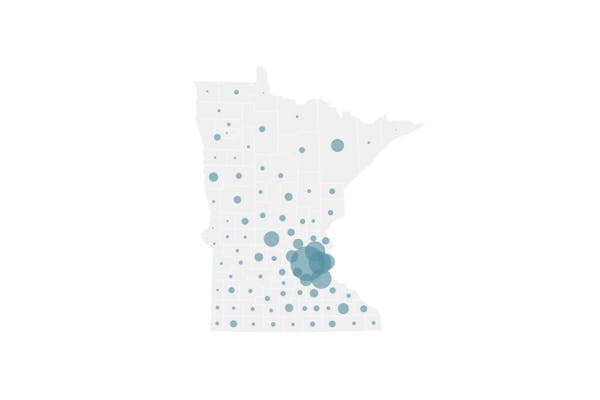Gov. Tim Walz declared a peacetime state of emergency Friday in response to the COVID-19 pandemic, including limiting large gatherings such as concerts, conferences, performances and sporting events.
"We are going into a heightened state of readiness to protect Minnesotans," he said.
The announcement comes as five more residents tested positive for the new coronavirus, bringing the total number of known cases in the state to 14.
The state's recommendations are also directed at workplaces, asking them to allow employees to work from home, stagger employee schedules and limit work travel.
Health care organizations were asked to restrict visitors and protect the elderly and people with disabilities.
"By taking these actions we can reduce the impacts," said Health Commissioner Jan Malcolm, especially for those who are at higher risk for COVID-19. "They need the rest of us to do our part to protect them."
The public health guidelines do not restrict operations at airports, health care facilities, shopping malls or libraries.
But gatherings of 250 or more people should be canceled or postponed. Smaller events should also be scratched if they can't keep people 6 feet from each other, the minimum "social distancing" guideline to stop disease spread caused by sneezing and coughing.
"These are recommendations, but they are strong recommendations," Malcolm said. "They do not at this point have the force of a regulation or law."
The emergency declaration, though, would give Walz the power to mandate the recommendations if necessary, she added.
As case counts increase nationwide, many states have banned large public gatherings, while others have shut down schools.
Minnesota Health Department officials reiterated again Friday that school closures are not recommended at this time.
Malcolm said the decision to keep schools open "runs counter to the instincts that many of us have" to close them and protect children.
"I don't blame anyone for asking these tough questions" about that decision, she added. However, she said epidemiological evidence indicates that COVID-19 isn't spreading as rapidly among children. She also noted that Hong Kong and Singapore have had similar levels of success in managing their COVID-19 outbreaks, even though the former closed schools and the latter did not as part of their strategies.
Parents of children with health concerns should consider distance learning as a precaution, the Health Department said. School closures could be ordered as the pandemic unfolds.
Nearly 138,000 cases and 5,100 deaths have been reported worldwide. Minnesota did not discover its first case until a week ago. Since then the number of cases has steadily increased.
Malcolm said that there are probably more cases in the state that are yet to be detected, especially given the testing delays that have occurred at the federal level.
"We acknowledge that it would be desirable to have the capacity to have more testing," Malcolm said. "We are urging the federal government to work with us and make broader scaled testing."
The state has asked for an increase that would allow it to test up to 15,000 patients per month. Walz said he had a productive conversation with Vice President Mike Pence about getting more tests to Minnesota.
So far, all of the Minnesota cases had some connection to travel, including two Hennepin County residents who tested positive after visiting HealthPartners urgent care clinics in St. Louis Park and Brooklyn Center.
Exposure risks were low and infection control protocols were followed, said Ashley Burt, HealthPartners spokeswoman.
Most patients have been recovering at home, but two patients were hospitalized, with one acutely ill, according to Malcolm.
A University of Minnesota student is among those who have tested positive and is recovering off campus, the university said Friday.
Organizations and companies across the state were already making changes with increasing frequency this week. Sports events and concerts are being canceled or delayed. Workplaces and universities are shifting into online mode to empty out offices and classrooms.
Pandemic plans have long been in place at the Health Department, including for the H1N1 flu virus in 2009 and the SARS outbreak in 2003, which was caused by a different type of coronavirus. State health officials began planning in mid-January as the new coronavirus emerged as a potential global threat.
For months, state officials have held briefings with educational institutions, health care organizations and the business community about preparing, including the challenges of keeping essential functions operating when there might be a shortage of employees due to illness.
"We know that these strategies are going to impact the lives of all of us," Malcolm said. "All Minnesotans share the risk and responsibility now."
If you are healthy and haven't been exposed to anyone who is sick, the new recommendations don't prevent anyone from going to the grocery store or getting other supplies.
"Stay home when you are sick," said Malcolm.
Walz acknowledged that Friday's guidance might need to be adjusted or refined for special situations, including all of the meetings and gatherings that accompany the Legislative session.
"This is about reducing a pandemic in society," he said. "We are not going to have people out there writing tickets for gatherings with 251 people."
Staff writers Jeremy Olson, Briana Bierschbach and Andy Mannix contributed to this report.

Want to share info with the Star Tribune? How to do it securely

'Safe recovery sites' would offer syringes, naloxone and more to people using drugs. The plan could be in peril.
New Minnesota GOP leaders seek peace with party's anti-establishment wing

Who is Republican Lisa Demuth, Minnesota's first House speaker of color?

